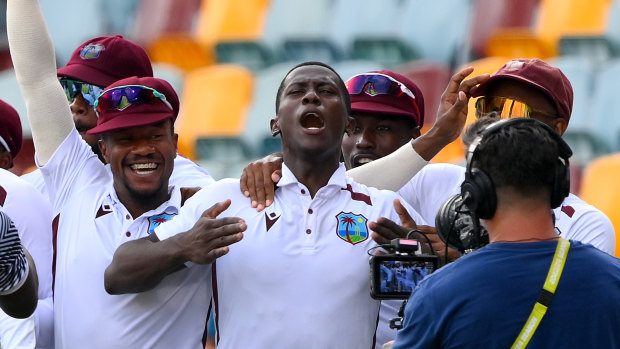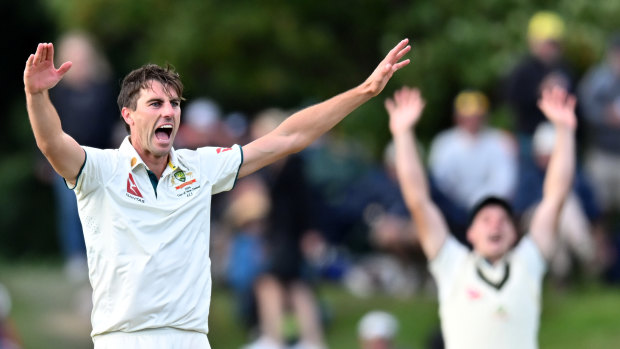Australia, England lobby ICC for increased payments to help save Test cricket
By Malcolm Conn
Australia and England will lead a push to establish minimum Test match payments for all male cricketers when the countries that comprise the International Cricket Council meet in Dubai from Thursday.
The international benchmark is expected to be set at the Australian Test fee of about $20,000 a match as a starting point, which is designed to make Test cricket more attractive to current and future generations of players as lucrative Twenty20 leagues lure some of the best talent away from the longer format. The minimum rate could go as high as the $27,000 fee that players who represent India currently receive.
Front of mind is exciting youngster Shamar Joseph, who bowled the West Indies to a spectacular victory in the last Test of the Australian summer in Brisbane two months ago.
While Joseph has pledged his future to playing Test cricket for the West Indies, there are fears that the Indian Premier League, in particular, will eventually prove too attractive, as it already has for a number of his countrymen.
Cricket West Indies retainers for players range from $US100,000 ($150,000) to $US150,000, with Test match payments of $US5000, among the lowest in the game.
Players of Joseph’s ability and charisma are earning $1 million or more per year in the IPL.
Cricket Australia retainers average almost $1 million a year on a sliding scale: captain Pat Cummins is paid $2 million and can earn another $1 million annually in match and tour fees, and from CA’s player marketing pool.

Shamar Joseph celebrates a remarkable Test victory with teammates at the Gabba in January.Credit: Getty
The difference is compounded by the struggling West Indies playing as few as six Tests a year. Australia played 22 in the past 15 months, which included an away Ashes series.
Following India’s 4-1 big win over England in their recent Test series, the Board of Control for Cricket in India announced a new incentive scheme encouraging their players to prioritise first-class cricket.
The “Test Cricket Incentive Scheme” will pay significant bonuses to those who become regular Test players, says BCCI president Roger Binny.

Pat Cummins will be the first player to earn $3 million in a year from Cricket Australia.Credit: Getty
“This scheme is not only designed to encourage players to engage in the purest format of the sport [Test matches], but also addresses the evolving dynamics of the cricketing landscape, ensuring parity with match fees in other formats and league cricket,” the BCCI said in a statement. “This initiative aligns with our vision of promoting Test cricket as the pinnacle of the sport.”
BCCI secretary Jay Shah said on social media that it was a “step aimed at providing financial growth and stability” for Test players.
As part of the payment process, anyone who plays at least 75 per cent of India’s Tests in a year will earn an extra $82,000 a Test, and anyone who plays between 50 per cent and 75 per cent of Tests annually will earn an additional $55,000 a Test.
This is on top of the country’s four-tier retainer system, which ranges from $183,000 to $1,278,000. On top of that, most leading India players are already wealthy because of significant corporate endorsements and IPL contracts.
One point of debate will be where the money comes from to cover the minimum Test match payments, and how will it be paid? Currently, all Test countries are paid a dividend by the ICC, which is vital for most nations given their modest broadcast deals.
Some countries have a history of not paying players in a timely manner, but there would be uproar from a number of countries complaining about a breach of sovereignty if the ICC attempted to pay their players directly.
The push by Australia and England for a minimum Test match payment is intended to be a top-up to bring all players to a similar level. That means cricketers from Australia and England are unlikely to get a pay rise unless India’s rate is set as the standard.
It is part of a wider agenda for the ICC to be more proactive in promoting and protecting Test cricket. A new development committee will be formed with its central focus to be the primacy of Test cricket.
South Africa sending a third-string squad to New Zealand recently will be on the agenda as part of this enhanced focus on Test cricket. Cricket South Africa administrators were forced to keep all their top-level players at home to play in a new Twenty20 competition run by IPL clubs.
Sports news, results and expert commentary. Sign up for our Sport newsletter.